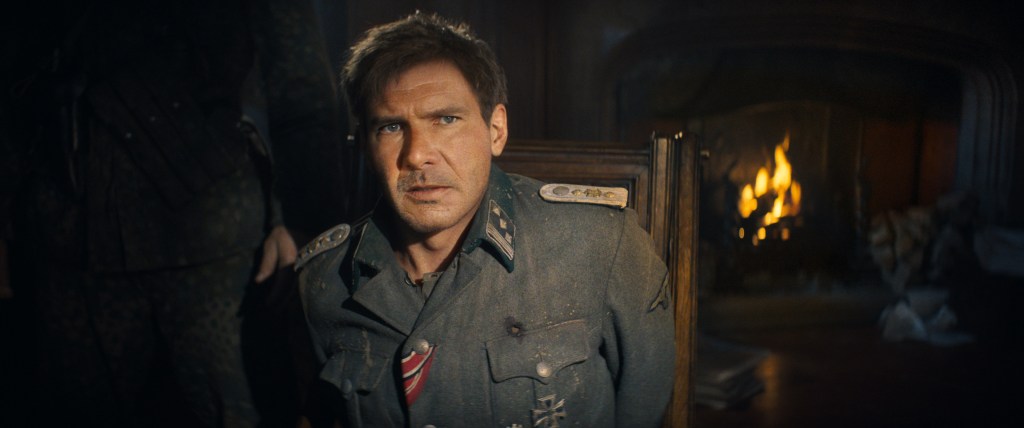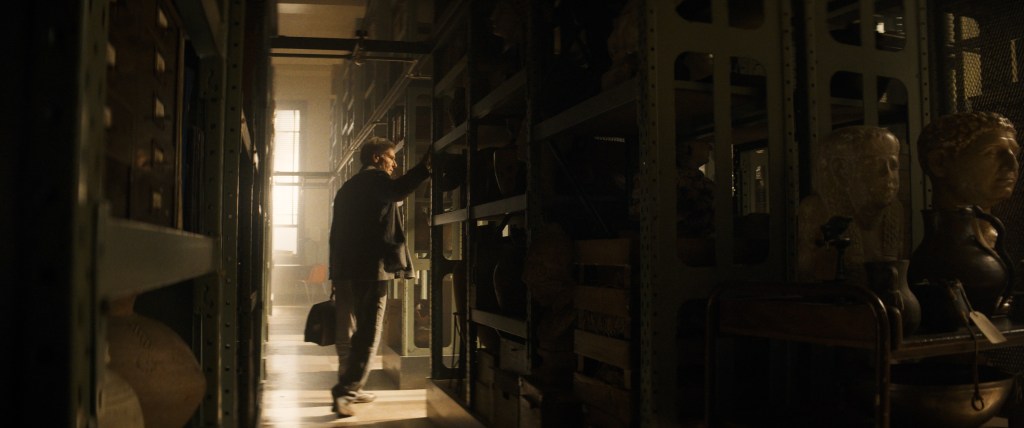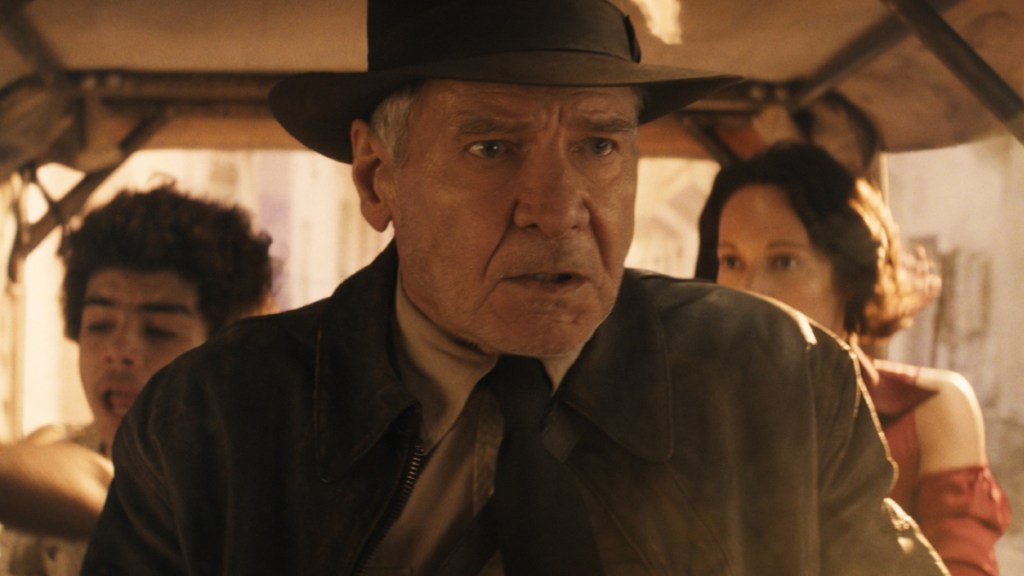Disney never quite had the chutzpah to put their castle logo at the front of a Star Wars movie, but they’ve done it to Indy. Indiana Jones and the Dial of Destiny gets that, then the Paramount mountain, then finally the Lucasfilm logo, thereby breaking the franchise tradition of having the Para-mountain dissolve into something very similar in the opening shot. Instead, the Lucasfilm logo dissolves into a similarly shaped lock on a Nazi truck, symbolism that Star Wars sequel bashers will no doubt have a field day with.

Indiana Jones (Harrison Ford) has taken on foes other than Nazis in his day, but with the resurgence of white supremacist groups in our era, he’s taken on cultural meme status as the patron Saint of Nazi-punching. So naturally, for his cinematic comeback and (alleged) grand finale, he’s back at it, first under a creepy digital makeover in a World War II flashback, and later in 1969, as a surviving Nazi (Mads Mikkelsen) and his followers of the neo-variety seek to regain prominence again.
De-Aging Ungracefully
Trailers have shown you the introductory shot of de-aged Indy, and that one looks all right, but as the scene progresses and he has to act, less so. First, there’s the old man voice that doesn’t quite track, then there’s the rubberiness and not-quite-matched lighting that send it to the edge of uncanny valley. When he runs across the top of a train that’s obviously had the background superimposed, it’ll bring back memories of The Polar Express to anybody who saw that one. It’s distractingly awkward, but director James Mangold piles on the action beats in a way that should eventually start to work on a primal level.
At least the sound has none of the issues of the visuals — Dolby Atmos today sounds like Dolby Stereo did back in the ’80s — a revelatory immersion. It goes a long way to compensate.

Ab Fab
Still, it’s a relief when the movie cuts forward 25 years or so, and we get 80 year-old Ford, whose abs — if they’re not digitally retouched too — still impress. Perhaps especially so, considering Indy’s now a breakfast-time drinker on the verge of retirement from teaching college classes in which no students find him sexy or even interesting anymore.
Content to slowly fade into the dark recesses of the local bar, he’s thrown back into action when his goddaughter Helena (Phoebe Waller-Bridge) comes to ask for his help finding the Antikythera, an artifact Indy was trying to liberate from the Hitler Express in the opening scene. Mikkelsen’s Jurgen Voller, also known as Professor Schmidt, was on that train as well, and hasn’t forgotten. Now a NASA rocket scientist, he has many friends in high places; Though even they can’t always cover for him when his goons go on a murder spree, as neo-Nazis are wont to do.
Eureka Moment
The Antikythera, incidentally, is a real thing, with a slightly different backstory. Believed to be the first known attempt at an analogue computer from the 2nd century, it may have come from Archimedes’ school, though the movie stretches things a little by naming him as the direct inventor, and imagining it cleaved neatly into two halves when it was lost, rather than many, many more fragments. Voller believes it also maps tears in the fabric of time, which we’d probably have detected by other means by now if they were real.
Jones. Indiana Jones.
James Mangold isn’t typically similar to Steven Spielberg in style, favoring a slower pace even when he’s making action movies. It shows here — individual sequences moves quickly, but the story feels episodic and long. One thing Mangold does get right that many feared he wouldn’t, however, is the way every Indiana Jones movie references the pulp movies of the era each one is set in.
That’s what many people didn’t like about Kingdom of the Crystal Skull — rather than riffing on adventure serials of the ’40s again, it aped nuke panic and UFO sci-fi B-movies of the ’50s. It’s also what some will bemoan about Dial of Destiny, which draws heavily from ’60s globetrotting action movies, meaning James Bond. Fans of that series will notice many direct riffs, but at 80, Ford’s not really going to be an effective womanizer decades before Viagra. (Not that it stopped Clint Eastwood in the Mule, but anyway. . .)

Things do eventually come back around to tomb raiding, and then something else entirely with reference points that would be spoilers. Along the way, Indy finds himself in an uneasy alliance with Helena and her kid sidekick Teddy (Ethann Isidore), who’s basically her Short Round, only less charismatic or fun. In another long-running series trope, there’s a huge, indestructible henchman (7-foot plus Olivier Richters), though it’s a shame he and Indy never really have a final knock-down, drag-out fight. Ford’s stunt team make him look like a total badass still, but perhaps they didn’t want to push the credibility of an octogenarian in a fight too far.
Cast Asides
Toby Jones makes a decent substitute Denholm Elliott — they’re not playing the same person, but might as well be — while Antonio Banderas hilariously gets almost nada to do but show up and drink. It’s easy to imagine his agent telling him it’s a nothing part, and him responding he’ll do anything to be an Indy movie. (If his upcoming action figure sells at all, it’ll be to customizers who want to turn him into Zorro.) Boyd Holbrook, as the main American neo-Nazi Klaber, does that thing he does, which is to utter crazy stuff in a drawl and shoot guns. Waller-Bridge may well be groomed for a spinoff and has a nicely nasty side that keeps her interesting. She should ditch the kid, though.

But it’s Ford’s show, always has been, and none of this would work without him. Any of us who have had a father Ford’s age will recognize the tics — the self-effacing jokes about putting up with him, the deep lingering sadness of old regrets, the impatience with shorter attention spans among the young, and the disappointment and anger that old cycles and enemies repeat themselves. He could be a surrogate for the star and his primary audience, not wanting to get sucked into one last giant franchise adventure, but feeling halfway alive again once it gets going. There’s a bit of Rise of Skywalker-style filling in of the blanks between movies, which works well enough. We get no mention of Short Round, sadly, but Temple of Doom does get a shoutout at the appropriate time.
Does It Belong in a Museum?
Obviously, nobody’s going to touch Raiders of the Lost Ark or Temple of Doom, at least not by doing anything remotely similar. But in the second tier of Indy movies (i.e., the rest of them), Dial of Destiny earns its spot. As James Mangold grand finales for icons go, it’s not as poignant as Logan, in part because that movie feared for all our futures while Indy still bathes somewhat comfortably in nostalgia. But even in the warm farewell comes a solid warning about time and cycles, and how festering regrets held by both villains and heroes can be deadly.
Grade: 4/5
Indiana Jones and the Dial of Destiny opens in theaters June 30th.




